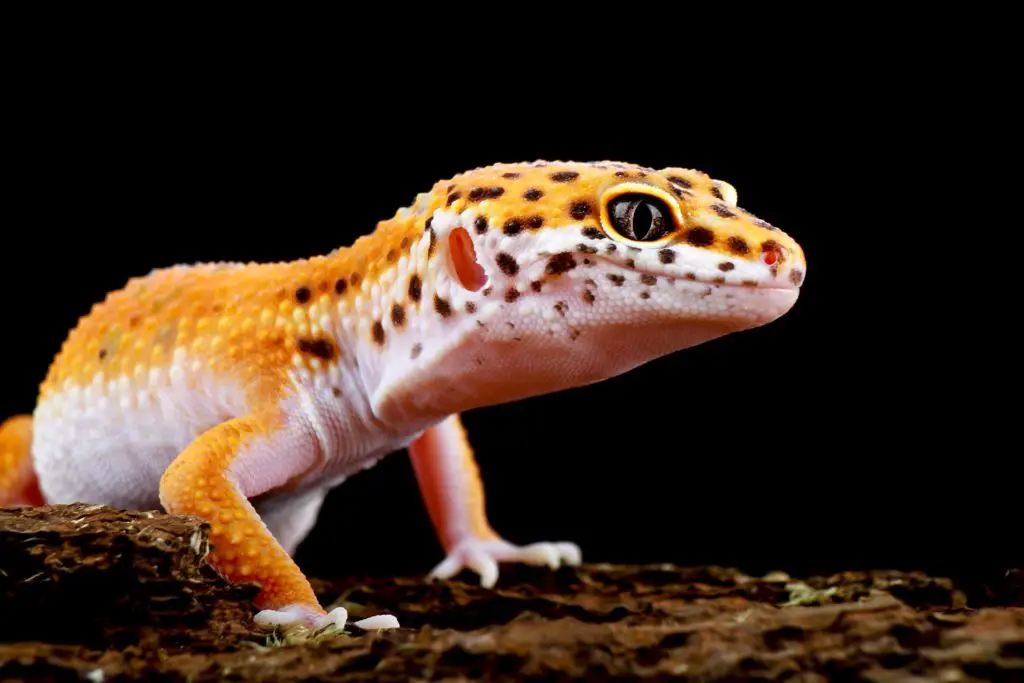Written by Frank Cuzzolina, the expert breeder behind Geeky Gecko Productions. This Leopard Gecko Care sheet provides all the information you will ever need to keep them happy and healthy!
Last updated on February 13th, 2023 at 03:15 pm
Leopard Gecko Diet
In captivity, Leopard Geckos eat crickets, mealworms, and dubia roaches. When it comes to feeding these to your pet, coming up with a schedule that works for both you and the animal is ideal.
For example, if you can only feed the gecko once a week, a small dish of mealworms mixed with the proper ratio of supplements (calcium with d3 & reptile vitamins) may work best for you.
But if you have the opportunity to feed crickets 2-3 times a week, you can drop in an appropriate amount each time. You can also tong feed dubia roaches 1x a week for geckos that will eat them because dubia roaches are very high in nutritional value.

Can I leave crickets in with my Leopard Gecko?
Although possible, I would not recommend leaving too many crickets in the cage with your gecko, especially if the gecko is in a small 10-20 gallon tank.
4-5 crickets running around the tank ok, but when too many insects are allowed to free roam in the tank they can stress the gecko out by bothering the gecko in the gecko’s hiding places, picking away at the gecko’s skin, and also eating the geckos feces.
When insects eat a gecko’s feces, whatever is in the feces, goes into the insects gut. If your gecko has a “small” amount of parasites (as some leopard geckos do naturally) living in its digestive tract, and then poops out some of those parasites, and then the insects eat the poop, the insects are now filled with extra parasites.
So if the gecko now eats the insects (filled with extra parasites), the gecko’s digestive tract will become overloaded with parasites, and this is where you might start to see some health issues in your gecko.
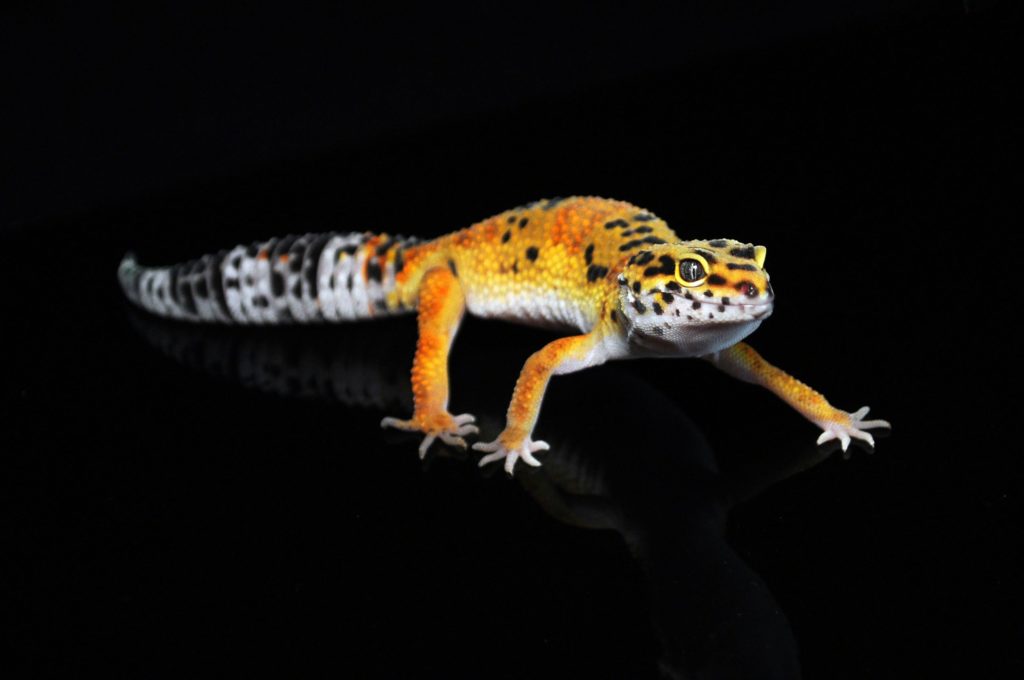
Do Leopard Geckos need UVB?
It is our observation that as a hobby, we have successfully been keeping leopard geckos in captivity for over 30 years, without any additional sources of UVB lighting. However new research is being done to show that certain reptiles can BENEFIT from UVB lighting.
More research needs to be done to compare the quality of health of geckos exposed to UVB versus geckos not exposed, but for now it is very common practice to NOT use UVB in leopard ecko habitats, so long as the geckos are getting a weekly dose of reptile calcium with D3 (sold at most reptile stores, and online).
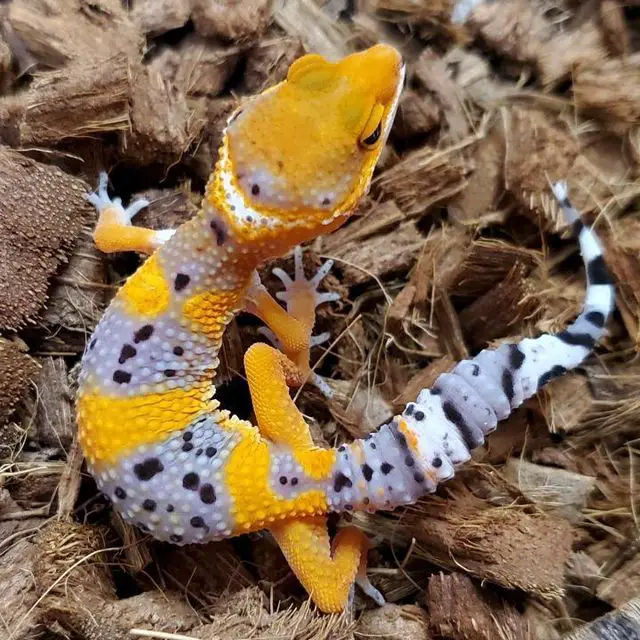
Leopard Gecko Habitat
Being primarily from the middle east (Afghanistan, Iran, Pakistan, and parts of India), the common species of leopard gecko we keep (E. macularius macularius) is from Dry Desert grasslands characterised by hot and humid summers, with dry and cold winters.
Because of this leopard geckos have been known to brumate in the wild (hibernation for reptiles), for many months. In captivity brumation is rarely practiced in the hobby however, and 99% of leopard geckos will show little to no signs of brumation if their habitat conditions are kept consistent year round.
The terrain they come from is also naturally rocky with a soil/sand/dirt mixture in which they love to hide in caves created by rocks and abandoned burrows of other animals. Despite being from a typically dry region, leopard geckos need humidity to shed, especially babies.
Making their homes in rocks, caves, and burrows gives them different “microhabitats” to find the proper level of humidity needed for shedding healthily in the wild. In captivity we simply provide 1 or 2 small hides that are kept warm and moist, around 85 degrees Fahrenheit (29 degrees Celsius), so the geckos can have the proper conditions to shed their skin each month.
Although not a huge risk to leopard geckos specifically, if the hides are kept too cold and moist, respiratory infections leading to potential health issues, and in worst cases death, may occur so suggested humid hides in the temperature range above mentioned would be best.
Leopard Gecko Setup
The best set up for your leopard gecko will vary depending on the size/health of your leopard gecko. If you have a juvenile or full grown leopard gecko that is healthy, free from any noticeable issues, and eating well, this type of gecko can be set up in almost anything. A 10-20 gallon tank, a 12 quart tub, or a custom 3 foot enclosure.
Size will not matter much since your gecko is healthy, alert, and all its instincts are working at 100%, it will find food, water, & humidity, just fine on its own. But let’s say you have a blind leopard gecko, sick leopard gecko, or small babies that are not doing so well. A smaller set up may work best.
I’ve noticed that some leopard geckos feel safer in smaller tubs naturally. I had this one Juvenile Black Night leopard gecko we purchased last year, it was small, we set her up in a 12 quart tub, because we were going to grow her out to be a breeder, so eventually she would live in a 12 quart tub anyway, since that is what we keep every one of our adults in.
Weeks went by and she started to get smaller, skinnier. I tried every trick I knew to get her to eat and drink in the 12 quart tub but she just would not thrive and grow. So I tried a trick that I have seen work before with geckos younger than she was.
I moved her into a smaller 6 qt tub. Right away she felt safer for some reason, she went back to eating right away, and today she is a perfectly healthy adult sized gecko.
If you decide to use a glass tank for your Leopard Gecko, read our post on recommended tank sizes.
Table: Leopard Gecko Enclosure size by age/health
| Size/health: | Enclosure size: |
| Adult | 10-20 gallon tank, 12 quart tub, or custom 3 foot enclosure |
| Subadult/fast growing baby | 12 quart tub |
| Shy/struggling baby | 6 quart tub |
What kind of decorations and hides do they need?
Decorations are up to you as the keeper. Feel free to put as many or as few as you’d like. The bigger the enclosure the more hides I would suggest to make the gecko feel safe.
It also gives them plenty of interesting space to interact with, they love to climb and move around and they will definitely go up and down and climb on top of anything you put in their tank, so make sure you have a lid!
At a bare minimum I would suggest you place at least one humid hide, on the warm side of the enclosure so it stays nice and warm/humid for them. This will help them shed and they will most likely spend a lot of time there because they absolutely love small, warm, humid places.
A food bowl will also be needed if you are feeding mealworms so they cannot escape and bury themselves under the substrate. We put our supplements/calcium powder directly in the bowl with the mealworms.
This makes sure the mealworms will be covered in the powder and they also eat it as the days go on to stay nice and gut loaded for the geckos, since sometimes your geckos will choose to eat the worms over the course of a few days.
If you feed crickets or roaches, you will have to dust them separately in another bag or container before dropping them into your gecko’s habitat or tong feeding them to your gecko.
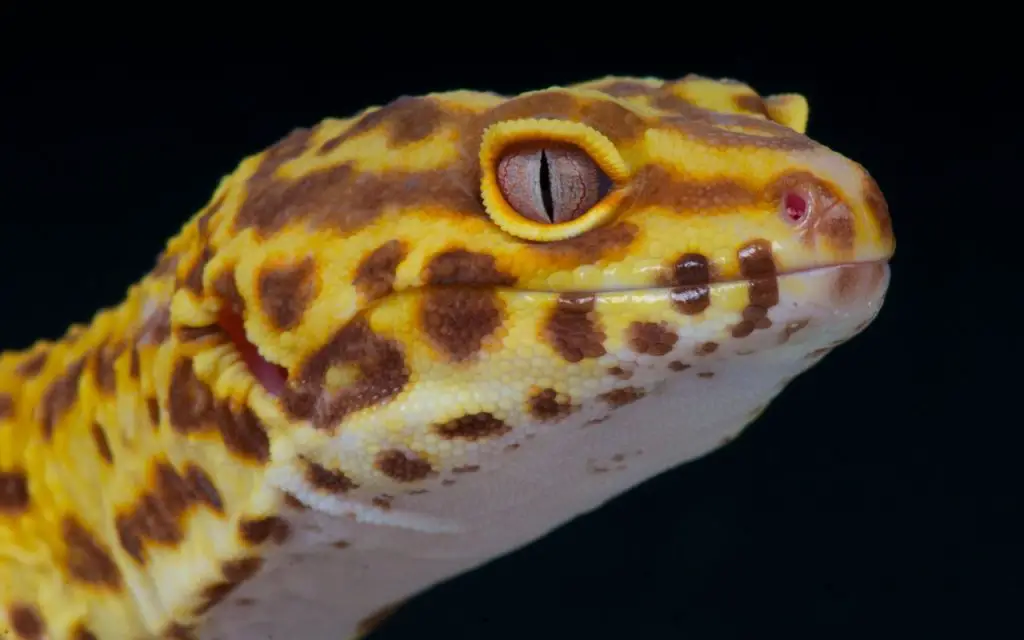
Water dishes
Personally I started using disposable water dishes, they are called “souffle” cups. You can get them from bulk restaurant websites or most food stores. These are good because every time you change the water you don’t have to worry about scrubbing away the bacteria build up on the bowl.
However if you do use a water dish just make sure you clean it well with a sponge once a week to make sure bacteria is not building up inside. Bacteria often feels “slippery” when you rub your finger along the water dish walls, so scrub away until you no longer feel that slipperiness.
Substrate
A big debate in the leopard gecko hobby has been whether leopard geckos could be kept on pure sand. Most geckos go a lifetime without any issues on sand but some have impaction issues.
I started keeping my geckos on paper towels. This is a good option but paper towel is very thin so it does not absorb feces and bacteria very well. Also the geckos push it around and shred it up to the point where it’s as if you are not even using any substrate by the time you go to clean it because it’s torn to pieces.
Also when the geckos go to breed on it, they slip and slide everywhere because of how slippery the paper towel is on most plastic/glass surfaces. I did my research and found out most impaction issues revolving around sand involved “Calcium Sand” found at pet stores, so I tried play sand from a local hardware store, which is washed, and chemical free.
This was great at first, it was really good at absorbing smell and bacteria, but over time it became very dusty which could get into the geckos lungs causing problems.
More seriously however, I started to notice dark blotches in the geckos’ bellies (most likely from eating sand). Shortly after I noticed actual sand grains in their stool. I did not feel comfortable keeping them on pure sand any longer for this reason.
I should note I was only providing a hot spot during this time of 90-93 degrees fahrenheit (32-33 Celsius). Newer studies suggest if you do choose to keep your geckos on pure sand (not mixed with dirt or soil) that a hot spot of 105-110 fahrenheit (40-43 Celsius), may provide the geckos a chance to digest and process the sand better.

What is the best substrate for Leopard geckos?
As a breeder, my all time favorite substrate is newspaper. I cannot express how good newspaper, or also similar, packing paper works. It is thick, so it absorbs way more liquid from feces and minimizes the spread of bacteria as the geckos splash water on their stools and walk over it before the next cleaning.
It also does not slide as easily or rip as easily so the geckos are not able to push it around or tear it up like they can the paper towels. I also never noticed any slipping issues with males and females during breeding, which can be dangerous if the males are slipping around and accidentally hurt their hemipenes. This can cause infection, ampution, and expensive vet visits.
In recent days a pure substrate of Eco Earth (ground up coconut husk) has been successfully used by leopard gecko rehabilitation centers such as Jessica’s Animal Friends on youtube. She is famous for using pure Eco Earth in all her rescued leopard gecko habitats, because eco earth does not cause blockages like pure sand substrates may.
Substrate for bioactive setups
If I were to set up a natural vivarium today for my leopard gecko, I would use what I use for my tegus, monitors, and other similar reptiles, a ⅓ x ⅓ x ⅓ mixture of eco earth (or organic peat moss), washed play sand, and organic top soil.
This is because eco earth (and also peat moss), is great for holding humidity, then sand is great for giving the substrate some structure, and lastly top soil is great for giving the substrate more volume and creating air pockets so it does not mold as easily.
This also allows for bioactive bugs such as isopods and springtails to more easily live and thrive in the soil. With a ⅓ mixture of sand only I would not anticipate any problems with impaction, but I would still give the gecko a slightly warmer basking spot of around 100-105 degrees fahrenheit (37-40 Celsius), to break down the little bits of sand they may get in their digestive tract.
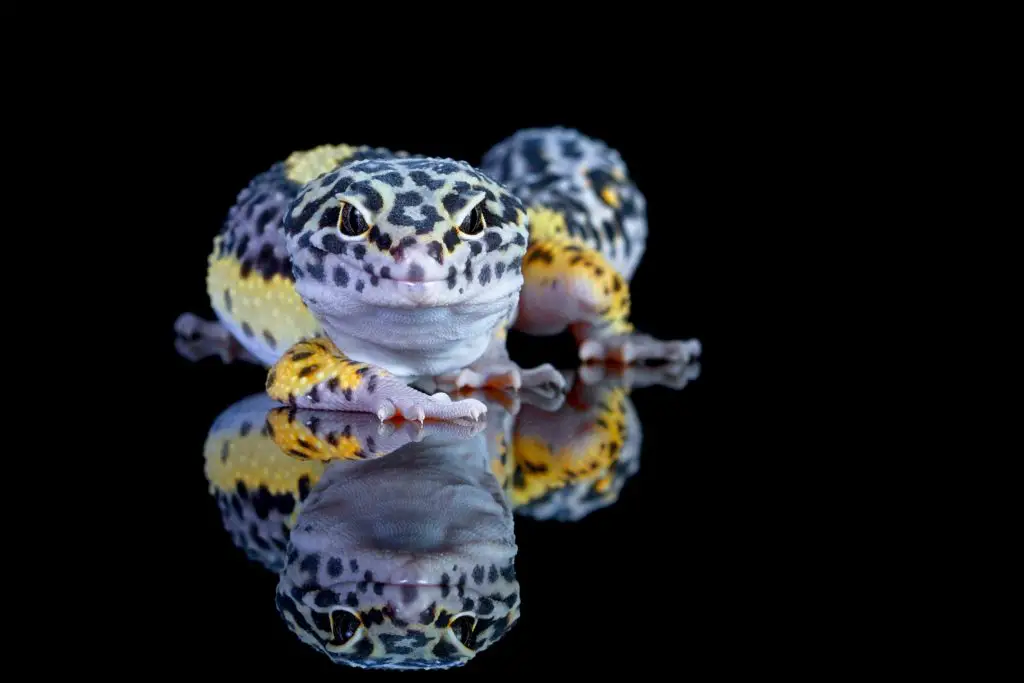
What substrates are harmful to Leopard Geckos?
Lastly, wood chips have been a popular option for reptile keepers of snakes/lizards for a long time. Personally, I would not recommend wood chips for the fact that they could have splinters, which may get caught in the gecko’s gut, mouth, or eyes.
Any other substrate not listed in this discussion may be there for a reason, do a little research whatever you are thinking of using, if it’s not something we have discussed.
Many soils, barks, wood whips, etc have chemicals added to it that could be harmful for your animal. This is why when I use sand/soil from the store I read the ingredients and make sure it is organic and pesticide/chemical free.
Safe vs hazardous and potentially hazardous substrates for Leopard Geckos
Safe substrates:
- Newspaper
- Eco Earth (coco coir)
- a ⅓ x ⅓ x ⅓ mixture of eco earth (or organic peat moss), washed play sand, and organic top soil.
Hazardous and potentially hazardous substrates:
- calcium sand
- pure sand
- wood chips
- barks
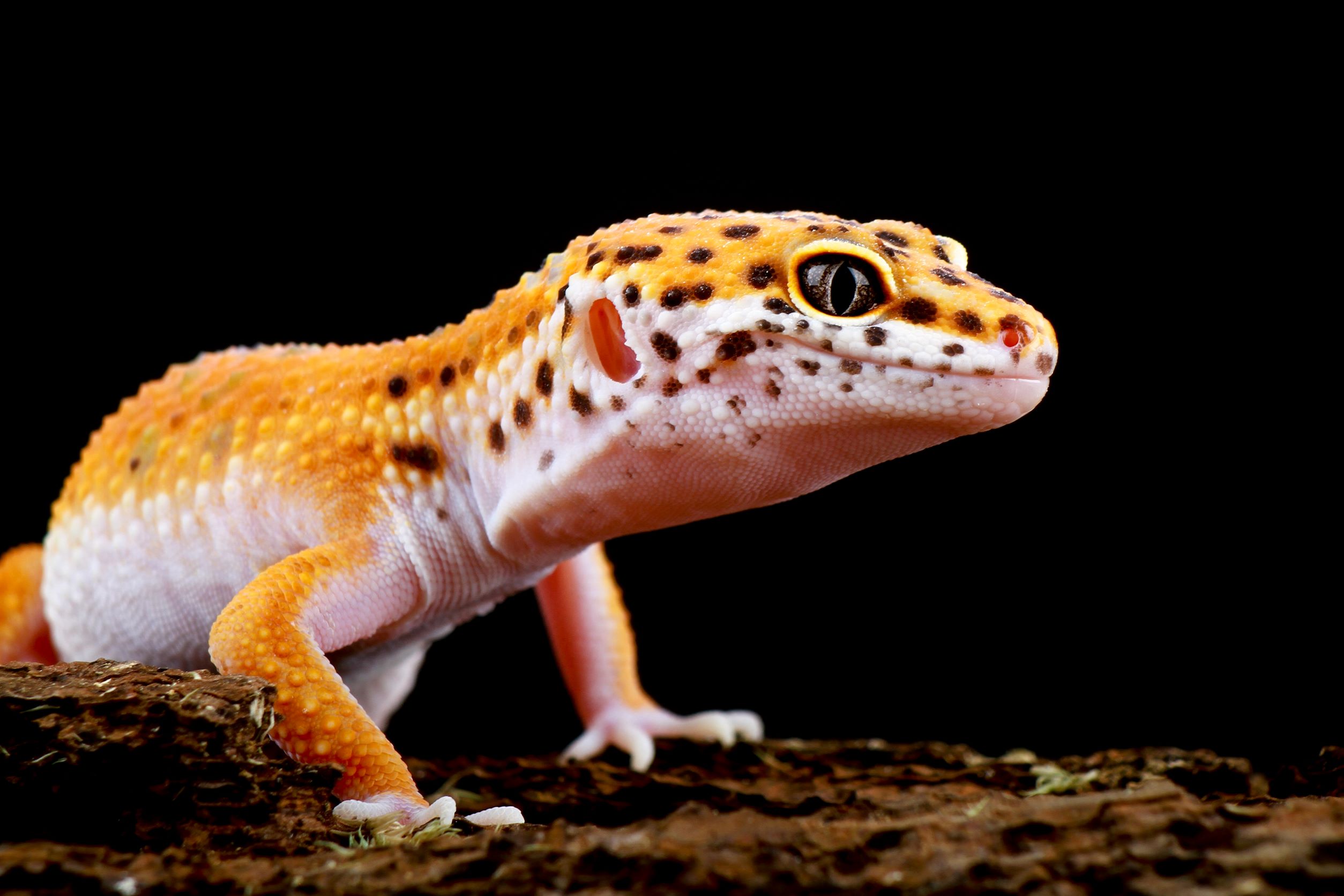
Temperature
Thankfully leopard geckos have fairly simple care requirements that allow for a range of heating options.
In general you’ll want to give your leopard gecko a hot spot of around 90-95 degrees fahrenheit (32-35 Celsius) with an ambient warm end of about 85 degrees and a cool side of around 75-80 degrees.
If you shut your heat source off at night I would recommend the gecko having an ambient temperature of somewhere between 75-85 degrees (23-29 Celsius). Geckos are very active throughout all hours of the day, they are opportunistic creatures that will hunt, sleep, and move about randomly throughout a 24 hour period.
Cooler night time temperatures that are drastically different than the day may promote brumation and confusion in the leopard gecko, so staying within the above mentioned ranges should promote year round consistent behaviour from your gecko.
Heating appliances
Whichever heating method you may choose, there are a couple warnings I can make based on experience you might want to be aware of.
If you use an over the tank heating element such as a heat bulb, be careful of the size of your enclosure to the wattage of the bulb. If the bulb puts out too much heat for the size of the enclosure, the entire enclosure may turn into a hotbox, producing too much heat for the gecko which can lead to infertility, health concerns, and in worst cases death.
You want to keep the hot spot around 90-95 degrees (32-35 Celsius), but also use a temperature gauge to make sure the cool side is staying around 75-80 degrees (23-26 Celsius).
Next, if you use an under the tank heating element such as heat tape, heat pads, or heat mats. Please know that those mats can heat up really high without you knowing.
The mats themselves usually heat up to around 115 degrees (46 Celsius), and more in some cases. So when you stick these directly to glass or the bottom of the enclosure, the surface temperature where the gecko will be sitting may get to 150 degrees (65 Celsius), or higher which could burn your animal.
So you really just need to be aware of this and adapt your heating conditions to be correct for the animal.
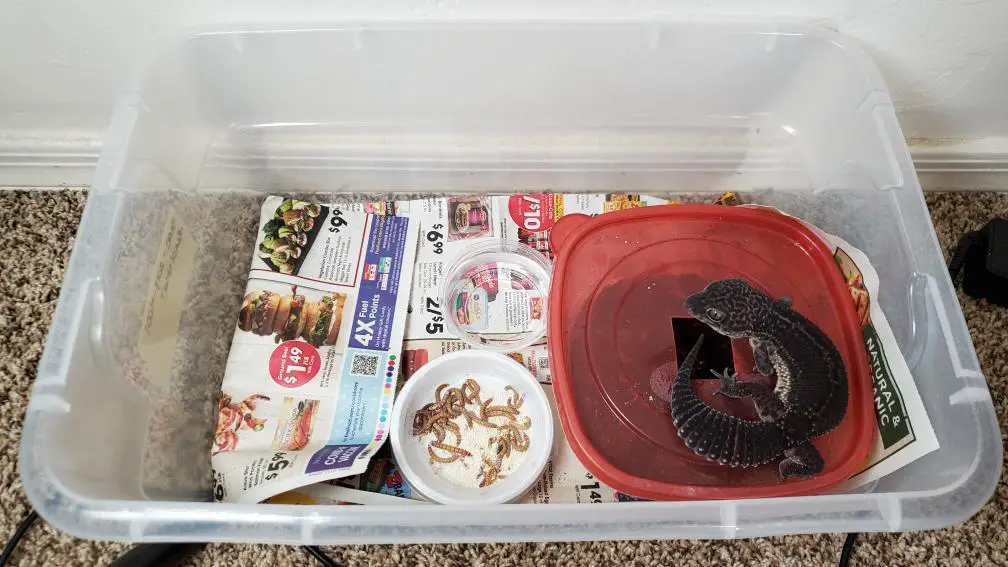
Using thermostats and heat guns to control temperatures
A couple options present themselves here, if you are using glass or plastic enclosures and the surface is getting too hot, you can use a thermostat to plug the heating source into and you can adjust the temperatures higher and lower based on the surface temperature you are seeing on the glass or plastic.
I would highly recommend buying a “heat gun” that shoots a laser beam to read the temperature on the surface of whatever you are aiming at.
These can be inaccurate by about 4-5 degrees, depending on how much money you spend on one, but even the cheap versions are fairly affordable at around $20 USD (17 EUR), but at least they give you an idea of where your surface temperatures are, whether they are in the danger zone or not.
Most reptile/fish thermometers are best used for reading air/water temperatures and not surface temperatures. This is the benefit of buying a temperature gun over these alternatives, because it will read the surface temperature for you by air, or by surface.

Water and Humidity
Leopard geckos are fantastically designed for survival. They gather a lot of their water requirements from food, such as insects and small mammals, but they do enjoy a good drink of fresh water whenever they can find some.
I can tell you this because we give our leopard geckos fresh water once a week and every time you can see them go directly to their bowl and drink.
Reptiles are not like us, they retain a lot of water from their food sources and in the case of leopard geckos they store nutritional elements in their tails. If you have a leopard gecko with a nice healthy tail, that leopard gecko can survive with very little resources for months, maybe longer.
Resilience aside, what you want to develop is a consistent source of fresh water for your leopard gecko. This is why I suggest changing their water once every 7 days.
Some leopard gecko keepers will only spray the enclosure once a week when they clean to allow their geckos to lick up fresh water for a few hours before it evaporates, but at the moment I like to provide an actual bowl.
This allows the gecko to drink up as much as they want over the next 2-3 days before the water goes bad, and they will most likely not drink from that specific source anymore.
Providing humid hides

Because we keep 100’s of leopard geckos individually on newspaper substrate we like to provide a naturalistic humid hide filled with eco earth for every single gecko we own, babies to adults. This makes us feel good as keepers, that we are providing some form of natural enrichment for the geckos, but it is also functional.
In the area of the United States where we are from, it is VERY dry. Even if you live in a humid location, if you have an air conditioning unit cooling/heating your rooms, this will suck most moisture out of the air immediately, making your gecko/reptile room very dry.
Adults are very forgiving and can often get away with little to no humidity, however baby/juvenile leopard geckos are much more sensitive.
We tried to keep baby/juvenile leopard geckos with no humid hide, but using the “spray” technique, where you give them a small turned over hide without any substrate, then simply spray once every 2-3 days to provide moisture for the geckos to shed.
The water evaporated every time within a couple hours, and the babies always had really bad sheds. This creates a lot more work for you in the long run spending 15 minutes per gecko trying to soak and pull off stuck shed. Also when you spray your geckos enclosure frequently for humidity purposes, you can’t help but soak their feces and urates at the same time.
This creates a terrible smell and a higher chance of respiratory infections or bacteria infections to spread because the geckos are walking,breathing, and living in their wet feces and urates constantly.
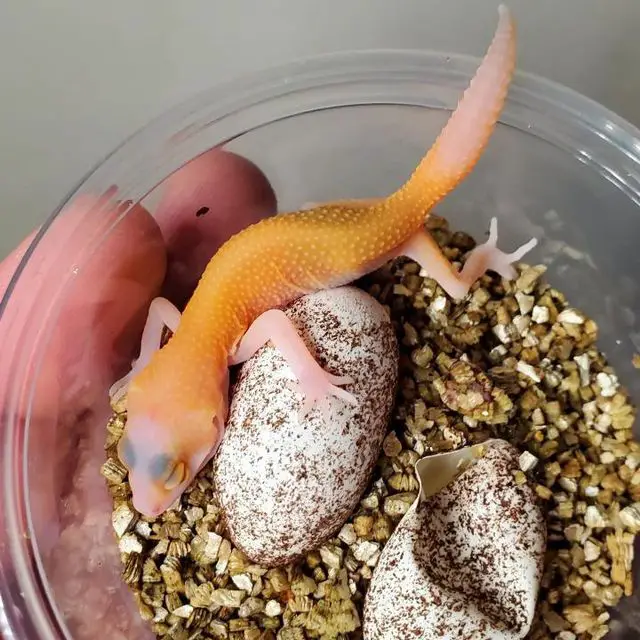
Provide one hide minimum on both the warm and cool side…
If you use eco earth or other kind of loose humidity retaining soil like substrate, all you need to do is provide one hide minimum on both the warm and cool side of the enclosure and spray the substrate regularly so the soil throughout stays a little compact, but not wet.
This will prevent the gecko licking up unnecessary amounts of soil into its digestive tract and also prevent the air in the enclosure from being very dusty.
You’ll also want to spray a bit extra inside the warm hide because this will most likely be the hide the gecko chooses for humidity, and a little extra moisture helps maintain a nice warm humid hide the gecko will love, again not soaking wet, just moist.
If you are looking for a suggested temperature range for the warm humid hide I would try to keep it around 82-85 degrees (27-29 Celsius).
As a suggestion if you are using newspaper or another substrate that does not retain moisture, what we have found best is simply to use tupperware containers with a hole cut in the top. Burn the edges of the hole (if they have sharp plastic pieces protruding), so that the lip of the plastic hole is nice and smooth so the gecko cannot accidentally hurt itself on.
This method works great for a humid hide for all geckos, but also as a lay box for females. However if you keep your leopard gecko on a humidity retaining soil like substrate, the female will most likely lay her eggs anywhere so keep an eye on her during breeding season so you know where she is laying.
Spraying your gecko directly is not recommended if possible…
In summary, spraying your gecko directly is not recommended if possible. Providing a humid hide that you do spray so the gecko can crawl in and absorb moisture is what we like to do. If you spray your gecko directly they will most likely scream and not like it.
Giving them shoulder high lukewarm baths at 80-85 degrees (26-29 Celsius), is acceptable and is another way to give them hydration. However in my experience most do not “like” to sit in the water and will try to get out. They like a small, dark, warm humid hide, 82-85 degrees (27-29 Celsius), that they can feel safe, secure, and invisible inside of.
Do Leopard Geckos like to be held?

Leopard geckos have been domesticated for 30+ years now in the hobby. Because of this, most have very calm demeanors. They are typically easy to hold and do not bite. However, there are always exceptions to this because every gecko is different.
I would say a small percentage of geckos do have a little bit more feistiness than normal. In most cases this can be eliminated by consistent handling over time. I use a technique called “open handed handling,” where you hold the gecko in the palms of your hands without grabbing them from above.
This allows for the gecko to feel safe and also prevents you from getting your fingers bit by being near the gecko’s face. This type of handling enforces a good experience for you and the gecko and with time, almost all geckos will be well behaved, even for children.
Baby and Juvenile leopard geckos usually take a little time to get used to handling. They are delicate and oftentimes very quick to try to scurry away. This may cause you as the handler to panic and try to grab your baby gecko from running away.
This is why I suggest when handling baby geckos to handle them sitting down in a closed off small area, so you dont panic if the gecko jumps out of your hands. In this way you can simply move around slowly and gently, allowing the gecko to crawl back onto your hand continuing its training process without many frantic moments for you and your gecko.
As far as frequency, if you want to hold your baby/juvenile gecko 1-2 times a day for periods of 15-20 minutes, in my opinion that is fine.

Leopard Gecko Lifespan
A wide range of lifespans have been reported in the hobby, anywhere from 8-32 years. Personally I am keeping track of all our geckos birth dates so I can compile a list of our own data of the general lifespan of our animals.
I think studying animals in different living conditions (breeding, temperature, environmental) will provide excellent data for studying the species as a whole. In general however, expect that your leopard gecko will likely live between 10-15 years if kept under proper conditions.
For more information, try reading my post on Leopard Gecko age.
Leopard Gecko Morphs
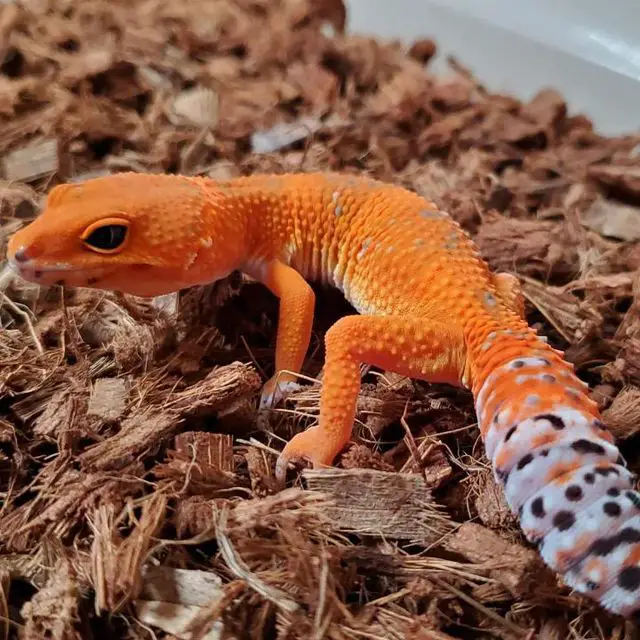
Leopard gecko morphs are one of the reasons that drive many to this niche of the reptile hobby. Not only are leopard geckos easy to care for, common, and make great beginner pets, add on top of that a designable template that is unmatched in the lizard world, and you have a hit!.
There are no other lizards that allow you to create artistic design through color and pattern manipulation as well as the leopard gecko.
Some of these morphs fall into what is called Mendelian inheritance (dominant, recessive, and incomplete dominant) traits. Other genetics fall into line bred traits (selective breeding for specific colors/patterns over time).
A really cool thing about leopard geckos is that you can do a fair amount of both of these types of breeding. I will give an example. Crested Geckos are primarily known for their “line bred” colors and patterns, and are almost bred exclusively according to line bred traits.
Ball pythons on the other hand are known for having so many mutations, but are bred almost exclusively on Mendelian based inheritance.
Leopard geckos fall into a very unique niche in the reptile hobby where it is almost a 50/50 split between breeding for line bred traits and mendelian traits.
Some of the most popular line bred traits would include: bold stripe, tangerine and black night. The most popular Mendelian mutations include: Snow, Albino, Eclipse, Blizzard, Murphy’s Patternless, and White and Yellow.
When you have the opportunity to combine both line bred traits and mendelian inherited traits, it opens up the world to varying levels of quality and combination that can be sought after.
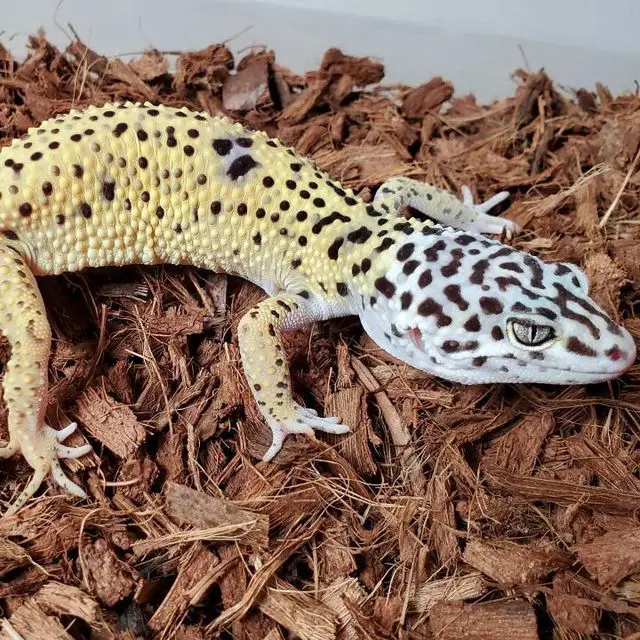
Popular Leopard Gecko morphs by type
Line bred traits:
- Bold Stripe
- Tangerine
- Black Night
Mendelian traits:
- Snow
- Albino
- Eclipse
- Blizzard
- Murphy’s Patternless
- White and Yellow
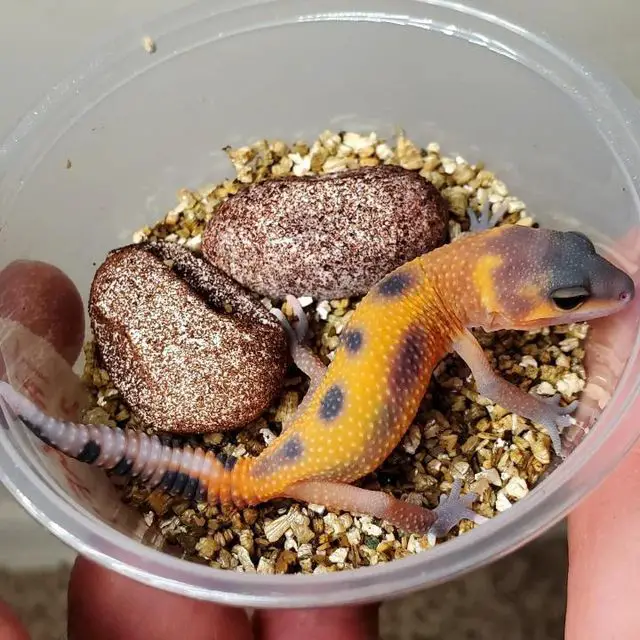
Leopard Geckos for Sale
It is a common thread that many of us buy our first geckos from pet stores with no prior research. Though the temptation is there, I would suggest trying to start your leopard gecko journey by researching information online and finding local keepers that you can become friends with through websites, forums, facebook groups, instagram pages, youtube channels, etc.
This will allow you to connect early on to trustable and reliable keepers who would know where to get good quality animals and would be able to help you with many of your first questions.
Use the internet for its advantages; connecting you to other people who have been doing this for a while will save you a lot of time and heart ache when it comes to commonly experienced issues for beginner keepers.
It may also be a good idea to ask a few people the same questions. This way you can see if they all have similar recommendations. Being so new, it will be hard for you to decipher between right and wrong information, so it is good to check with multiple sources before making your final decision on things.
Table: Leopard Gecko care summary
| Common name: | Leopard Gecko |
| Scientific name: | Eublepharus macularis |
| Distribution: | (Afghanistan, Iran, Pakistan, and parts of India |
| Activity rhythm: | Cathemeral (active night and day) |
| Habits: | Uses caves and crevices to hide |
| Habitat: | Dry desert and grasslands |
| Temperature: | – basking spot: 90-95f (32-35c) – cool end: 75-80f (24-27c) |
| Humidity: | Low to moderate, but humid hides are a must! |
| Favourite food: | Crickets, mealworms, and dubia roaches |
| Enclosure size: | – adults: 10-20 gallon tank, a 12 quart tub, or 3 foot enclosure – juveniles: 6 or 12 quart tub |
| Lighting needs: | UV not needed if supplements are used |
Thanks for reading! If you’d like to learn about a very similar species, check out our African Fat-tailed Gecko care guide.

